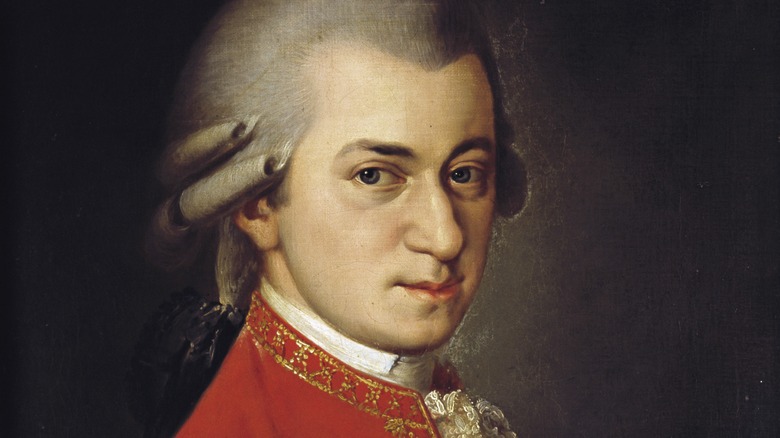Historians Believe This Was Mozart's Favorite Meal
When Wolfgang was wolfing down food, he was known to dig into liver dumplings (one of dozens of types of dumplings) pan-fried in clarified butter (not boiled, steamed, or served in soup broth) with sauerkraut on the side. This rare peek into the composer's personal life comes from a letter written by his father Leopold Mozart to Wolfgang's mother and sister when the would-be composer was still a young boy of 14. Quoth the letter, via the American Classical Orchestra NYC, "We lunched on Thursday with Madame D'Aste, née Marianne Troger, who fed us most magnificently on liver dumplings and sauerkraut, which Wolfgang had asked for."
While it's not clear from Mozart (or his father's letter) that this was his all-time favorite dish, in Austria today, some wirsthausen (Austrian-style inns or taverns with a focus on local, traditional fare) are serving up what was allegedly Mozart's favorite meal, leberknӧdel mit sauerkraut. As he would have enjoyed them at the time, the leberknödel dumplings are made from a combination of beef and pork livers, which are ground in a meat grinder and mixed with breadcrumbs, milk, butter, onions, eggs, parsley, and nutmeg. In one 1791 letter to his wife, Mozart mentioned pork cutlets, writing "Che gusto! Now I am eating to your health!" via classic music news outlet Interlude. Other records show that the composer was fond of other traditional Austrian dishes, including wiener schnitzel, tafelspitz boiled veal, kaiserschmarrn sweet pancakes, and jammy Linzer torte.
Wolfgang liked his liver dumplings pan-fried in butter with a side of sauerkraut
Like his father, Wolfgang Amadeus Mozart was something of an avid pen-pal himself. In his life's library of letters sent to his family until his death in 1791, Mozart made frequent mention of the lavish feasts and dinner parties he attended, and although he painted flowering descriptions of the table chatter and seating charts, he never really mentioned what foods were served.
For more clues about what Mozart might have eaten, it could be helpful to take a look at the common diets of his contemporaries. During the Baroque era in Vienna, a typical meal consisted of at least eight courses, often including two meat dishes (ragout, ham, tongue, sausages, meat pies, venison pâte, and smaller roasted game birds), vegetables, soup, and copious amounts of wine and bread. By the time the fifth course rolled around, writes Joseph Wechsberg in "The Cooking of Vienna's Empire" (1968), "One would expect to see some guests retiring from the scene, but no one seems to have left the table or been afraid of having a stroke," via FoodTimeline. On the sweeter side, Vienna at the time was renowned for its baked goods, like bread, plush rolls, pastries, marzipan, gingerbread, almond biscuits, and tart-like cakes topped with whipped cream.

